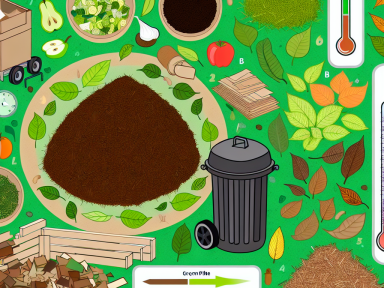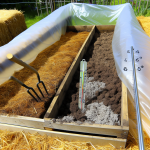The Power of Compost
Compost is more than just a method of recycling organic waste; it is a powerful tool that can significantly enhance the quality of your garden soil, promote vigorous plant growth, and help the environment. To unlock the full potential of composting, it is essential to understand its nuances and how to use it effectively.
Creating the Perfect Compost
Ingredients Matter: The foundation of excellent compost lies in the quality of its ingredients. Aim for a balanced mix of green (nitrogen-rich) and brown (carbon-rich) materials. Here are some examples:
- Green Materials: Vegetable scraps, coffee grounds, grass clippings, and fresh leaves.
- Brown Materials: Dried leaves, straw, cardboard, and wood chips.
The Right Ratio: A crucial aspect of composting is maintaining the correct ratio between green and brown materials. Generally, a 2:1 ratio of brown to green materials works well. Too much green material can result in a smelly, nitrogen-rich compost, while too much brown can slow down the decomposition process.
Size Matters: The smaller the pieces, the faster they will break down. Shred or chop large items before adding them to your compost pile.
Maintaining Your Compost Pile
Turning the Pile: Regularly turning your compost pile is essential for aeration, which promotes the activity of aerobic microbes that break down the organic matter. Aim to turn your pile every 1-2 weeks.
Moisture Level: An optimal compost pile should be as damp as a wrung-out sponge. If it’s too dry, add water. If it’s too wet, incorporate more brown materials to absorb the excess moisture.
Temperature: A well-maintained compost pile will heat up as the microbes break down the organic matter. The ideal temperature range is between 135-160°F (57-71°C). Use a compost thermometer to monitor this, turning the pile if it cools down too much.
Harvesting and Using Compost
When is Compost Ready? Finished compost is dark, crumbly, and has an earthy smell. It can take anywhere from 3 months to 2 years, depending on various factors such as materials used, pile management, and environmental conditions.
Application Methods:
- Mulching: Apply a 2-3 inch layer of compost around plants to help retain moisture, suppress weeds, and add nutrients to the soil.
- Soil Amendment: Mix compost into garden beds before planting. Aim for a ratio of one part compost to three parts soil for most garden plants.
- Compost Tea: Steep finished compost in water to create a nutrient-rich liquid. Use this “tea” to water plants, giving them a quick nutrient boost.
Common Compost Problems and Solutions
- Odor Issues: A foul smell usually indicates an imbalance or lack of aeration. Add more brown materials and turn the pile to introduce oxygen.
- Pest Attraction: Avoid adding meat, dairy, or oily foods to prevent unwanted visitors. Cover vegetable scraps with a layer of brown materials immediately after adding them.
- Slow Decomposition: If the pile isn’t breaking down efficiently, it might be too dry, too wet, or lacking in nitrogen. Adjust moisture levels and balance the green-to-brown ratio.
By understanding and implementing these composting strategies, you can transform kitchen scraps and garden waste into “black gold” for your garden, resulting in healthier soil and more robust plants.




GIPHY App Key not set. Please check settings